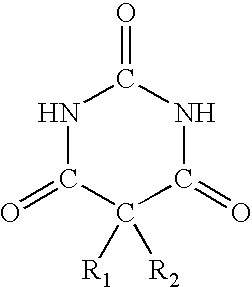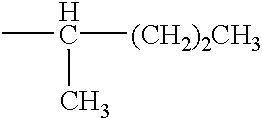The amount of
styrene-
maleic anhydride can be adjusted by the ratio of
styrene to
maleic anhydride. The number of the repeating unit is from about 1:1 to 3:1. The higher the relative amount of
styrene, the harder the modified resin will be, however, the amount of substitution group elements is reduced. When the ratio of repeating units is greater than 1:1, the more the unsaturated
double bond is introduced, which in turn, increases the degree of crosslinking and
photosensitivity. Moreover, the more of the hydroxyl group that is introduced, the easier the development of the photosensitive layer will be. But more hydroxyl groups do not guarantee the improvement of resolution or adhesion. A suitable ratio of amount and other additives used must be employed. The preferable molecular weight of styrene-
maleic anhydride is between 800 and 100000. When the molecular weight is lower than 800, film formation is poor, and there will be problems of absorption and
pollution of the disposure film after
drying and
exposure. On the other hand, when the molecular weight is greater than 100000, problems such as unclean development will occur. Suitable styrene-maleic anhydride is selected from SMA1000, SMA2000 and SMA3000 (the repeating unit of styrene and maleic anhydride is 1:1, 2:1 and 3:1 respectively; available from ATO company).
The main function of the unsaturated alcohols is to provide an unsaturated
double bond for the film-forming
polymer. Also, by having at least three acrylic groups in each molecule, after it is reacted with the anhydride group, enough unsaturated vinyl groups are introduced in the
side chain of the styrene-maleic anhydride. This will enhance the degree of crosslinking and photosensitivity of the photosensitive composition. Suitable unsaturated alcohol is selected from low volatile alcoholes, such as pentaerylthritol triacrylate (PETA) and dipentaerylthritol pentacrylate (DPPA). Between them, DPPA is able to introduce more double bonds. Therefore, it has higher photosensitivity, but the film formed is softer. PETA, however is able to form harder
polymer, because it has a lower molecular weight. After
grafting, the
side chain is shorter, which increases the
hardness of the
polymer. Due to the high demand of hard solder
resist material, PETA is preferable. In styrene-maleic anhydride, the ratio of the anhydride group and the hydroxyl group of unsaturated alcohol is preferably between 1:0.05 and 1:0.9, most preferably between 1:0.2 and 1:0.7. When unsaturated alcohol is used excessively, the
hardness of the
coating tends to be insufficient. If the amount of the unsaturated alcohol is deficient, the double bond is inadequate, lowering photosensitivity.
The main function of the saturated alcohol is to participate in the ring-opening reaction, and introduce a sufficient number of hydroxyl groups in the
side chain of the film-forming polymer. The structure of general saturated alcohol is not limited, as long as it is not an irritant. Examples are
alkyl alcohol, such as
ethanol, n-
propanol, iso-
propanol, n-
butanol, sec-
butanol, iso-
butanol, n-pentanol, 2-methyl-1-butanol, isopentyl alcohol, n-hexyl alcohol, n-
heptyl alcohol, n-octyl alcohol,
cyclopentanol and
cyclohexanol, and
ether alcohols such as
ethylene glycol
monomethyl ether,
ethylene glycol monoethyl
ether,
ethylene glycol monobutyl
ether, carbitol, propyleneglycol
monomethyl ether and dipropyl
diol methyl ether. The amount and the size of molecules of the above saturated alcohols will affect the number of hydroxyl groups and hardness of the film-forming polymer. Generally, the more saturated alcohol that is used, the higher the ratio of the anhydride ring-opening will be, which results in easier development of the photosensitive material. Preferably, the equivalent amount of the anhydride and the saturated alcohol is between 1:0.2 and 1:10. The size of the molecules of the saturated alcohol will affect the distance between the chains of the molecules. Usually, the less saturated alcohol is used, the harder the film gets. Before exposure, if the film is too hard, it is unfavorable to photosensitivity. The amount and size of the saturated alcohol molecules used relates to
acid value and degree of hardness. In addition, the two properties also relate to other additives.
The
photoinitiator used in the photosensitive composition of the invention is not limited. For use with liquid photosensitive material, however, preferably with high light-absorbing
decomposition, reducing the crosslinking problem on surfaces caused by the suppression of
oxygen. Suitable photoinitiators are selected from 2-dimethoxy-2-
benzil dimethyl ketal, 2,4-diethylthioxanthone,
isopropylthioxanthone, 2-methyl-1-(4-(methyl-
thio)
phenol)-2-morpholinopropanone-1),
benzophenone etc. To enhance photosensitivity, 2-dimethylaminoethyl benzoate, ethyl(p-dimethylaminio)benzoate or Michler's
ketone can be added.
 Login to View More
Login to View More 


